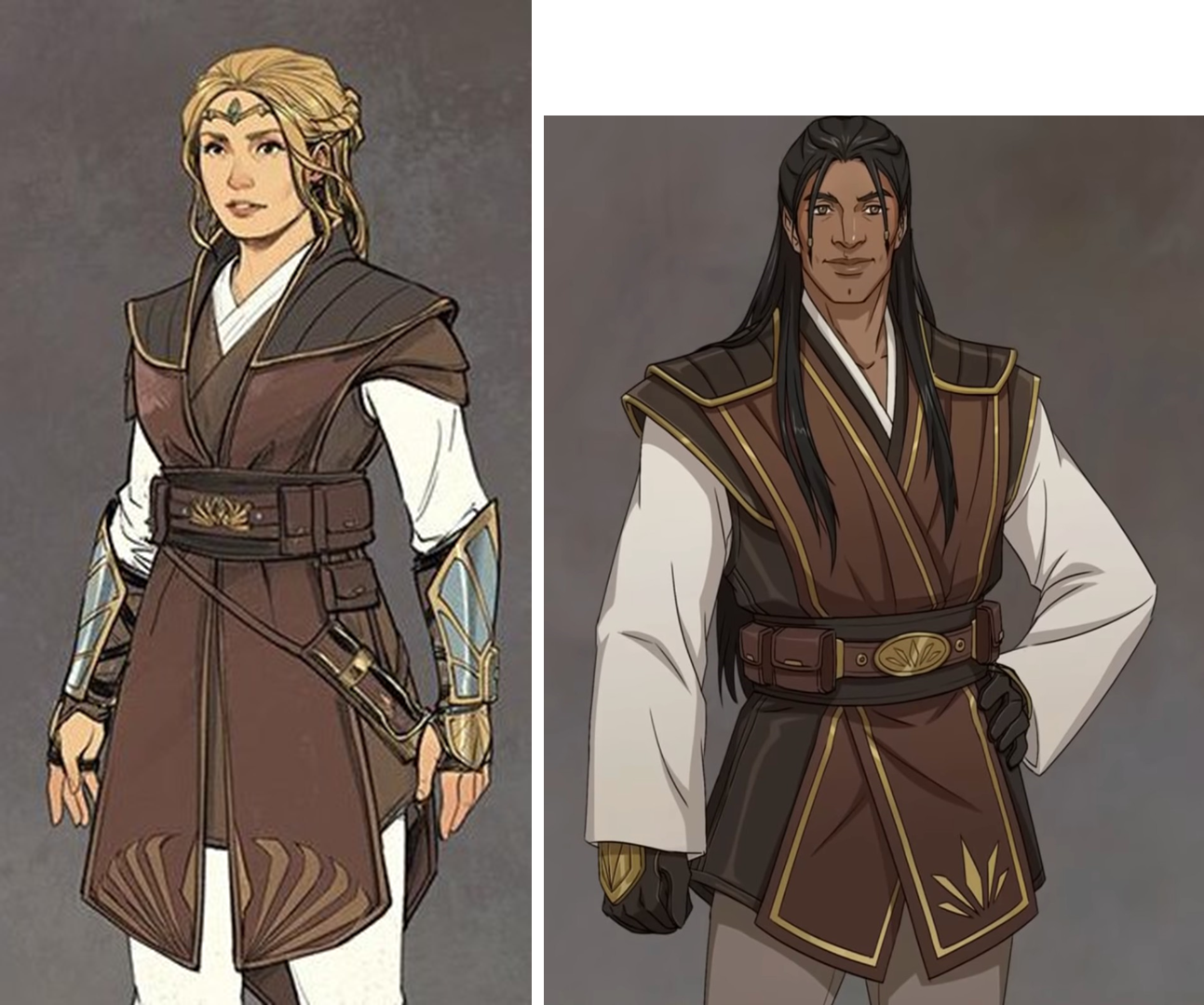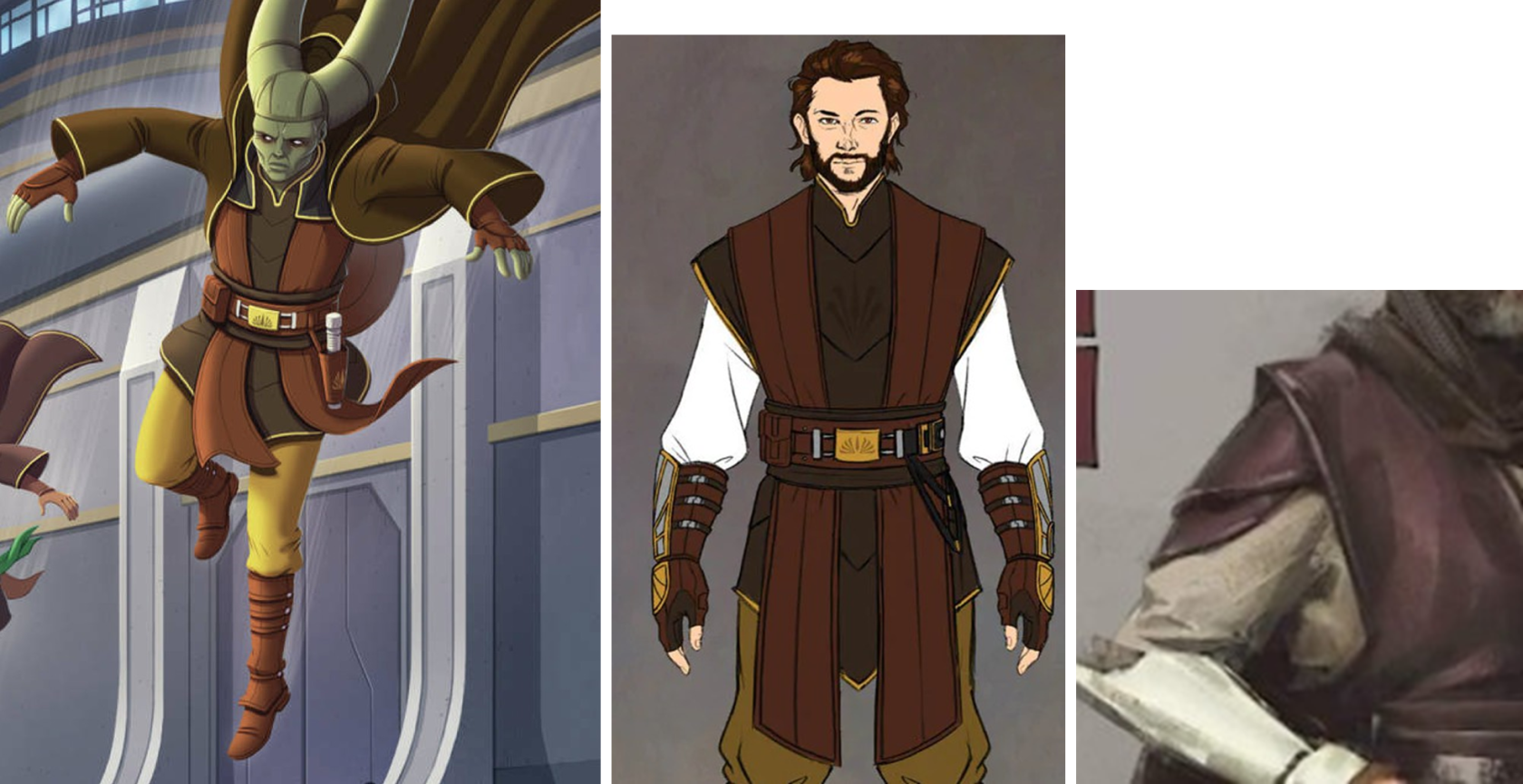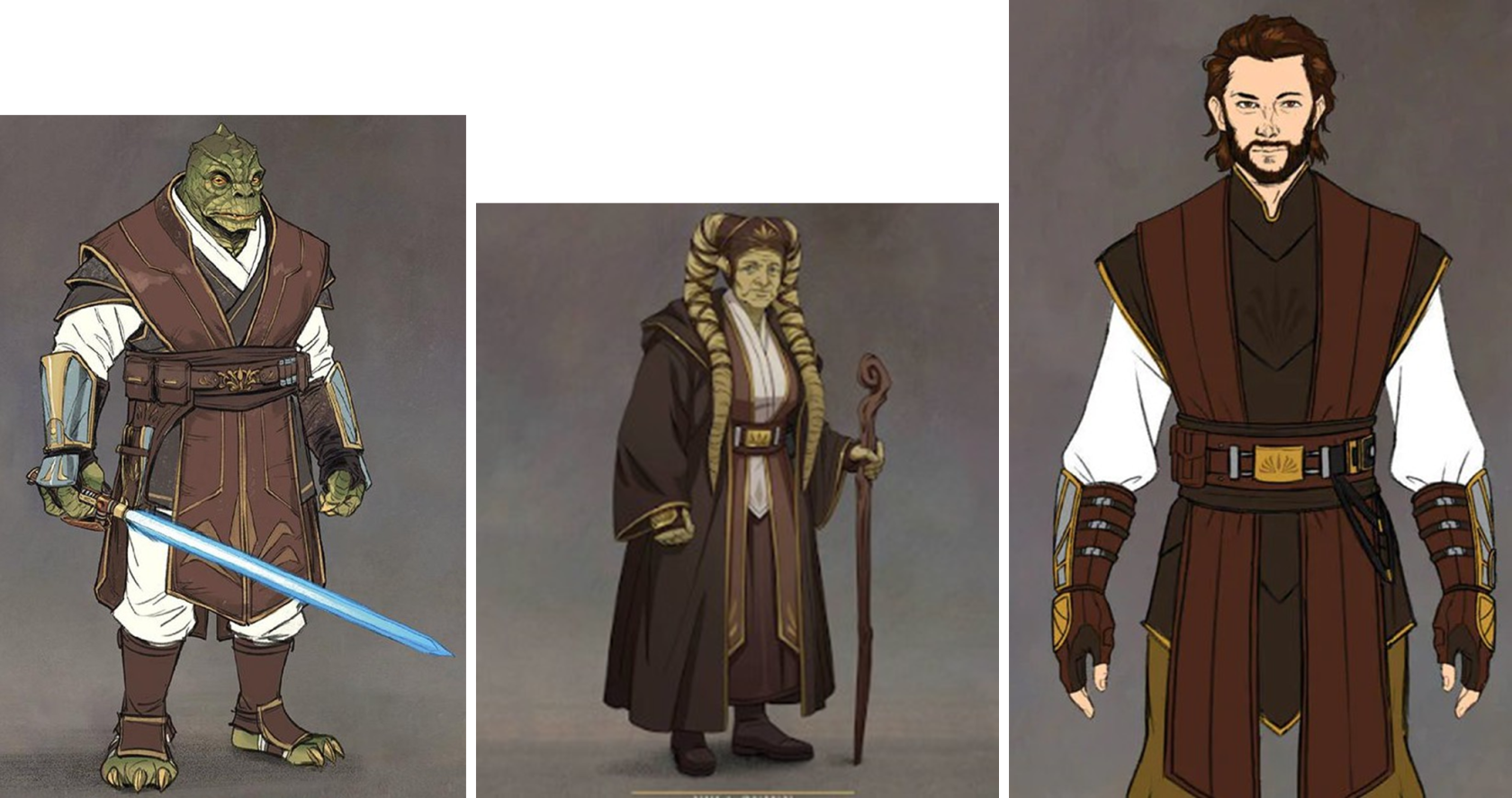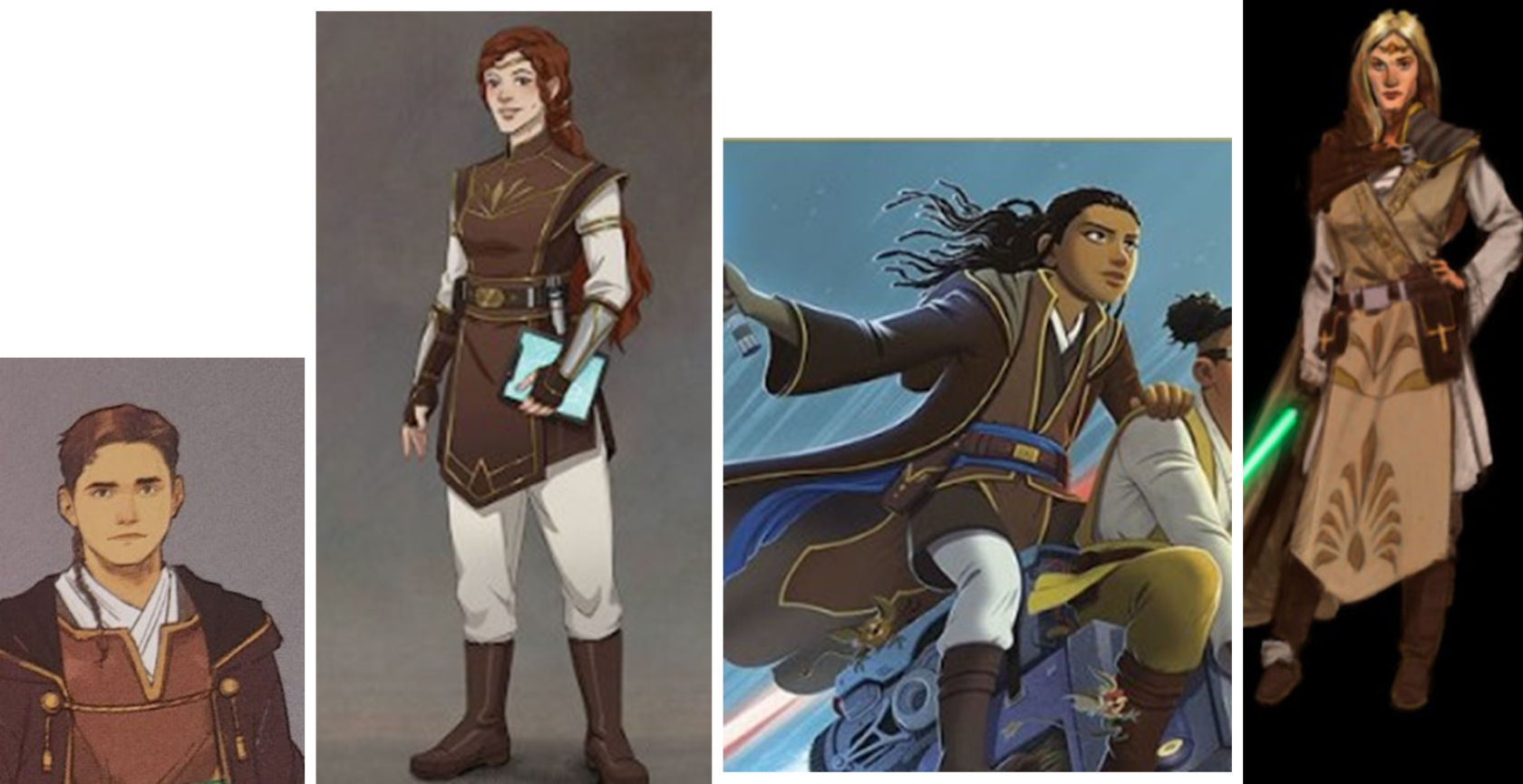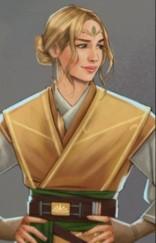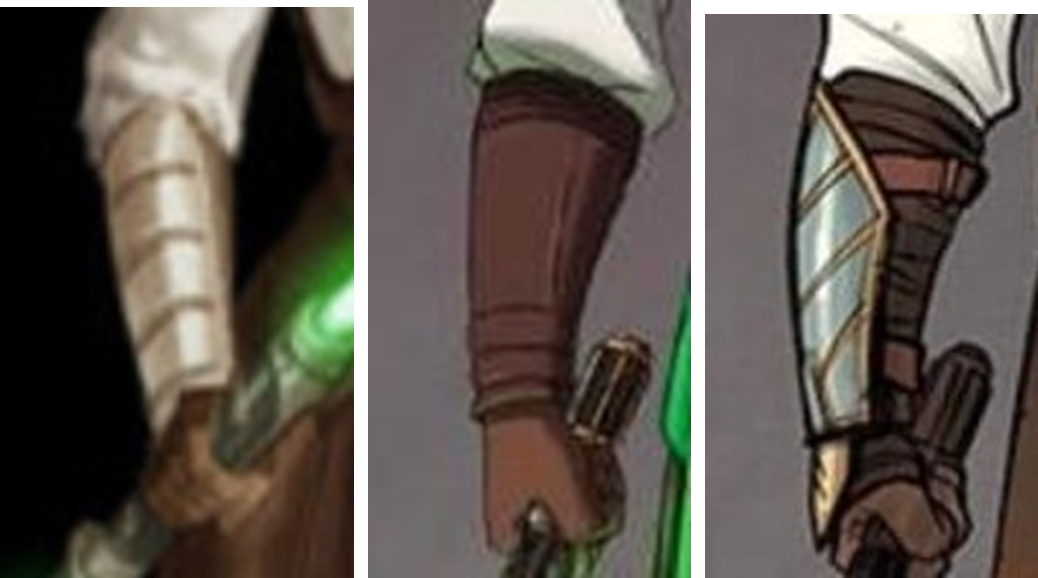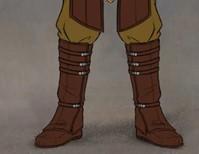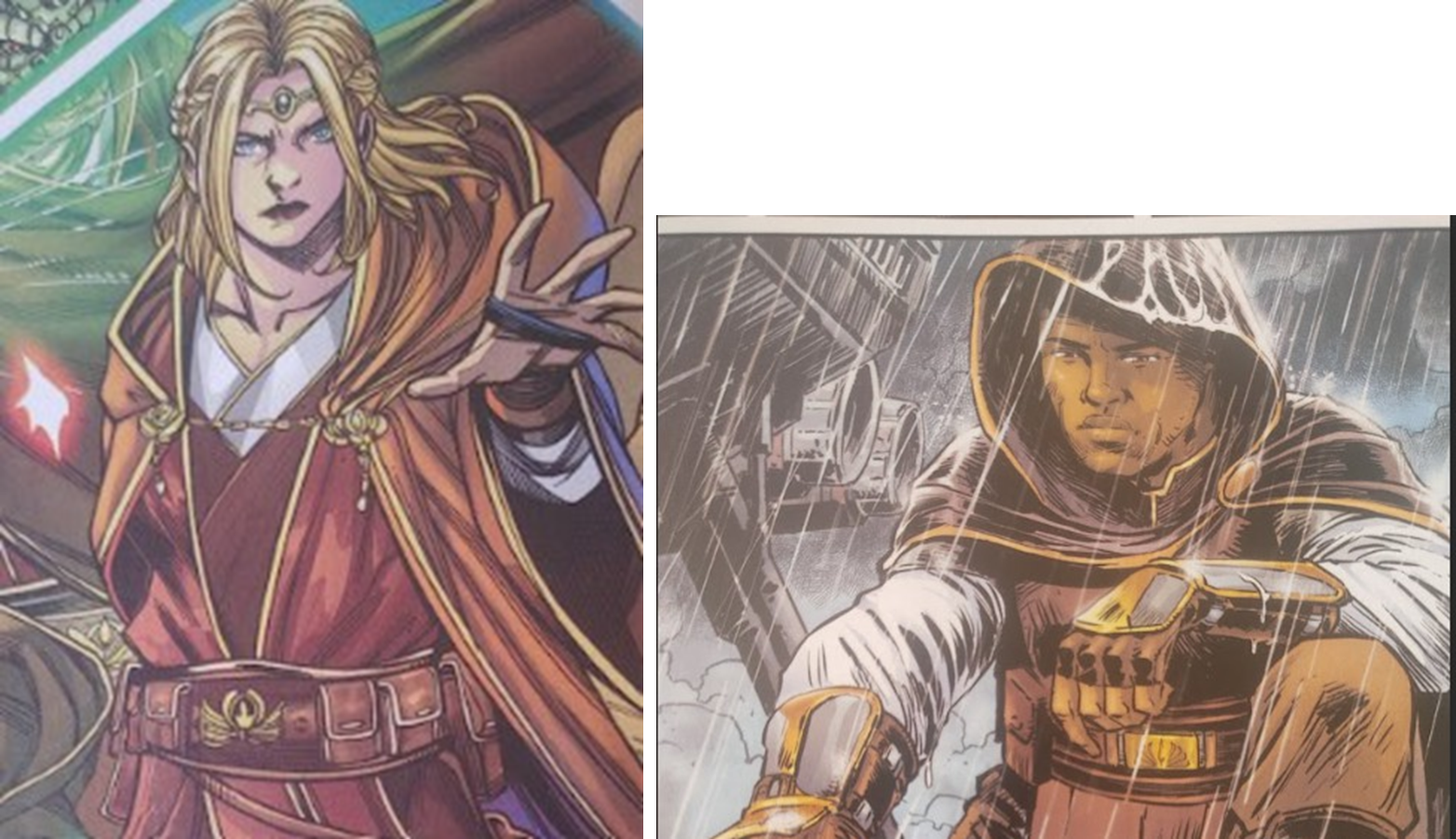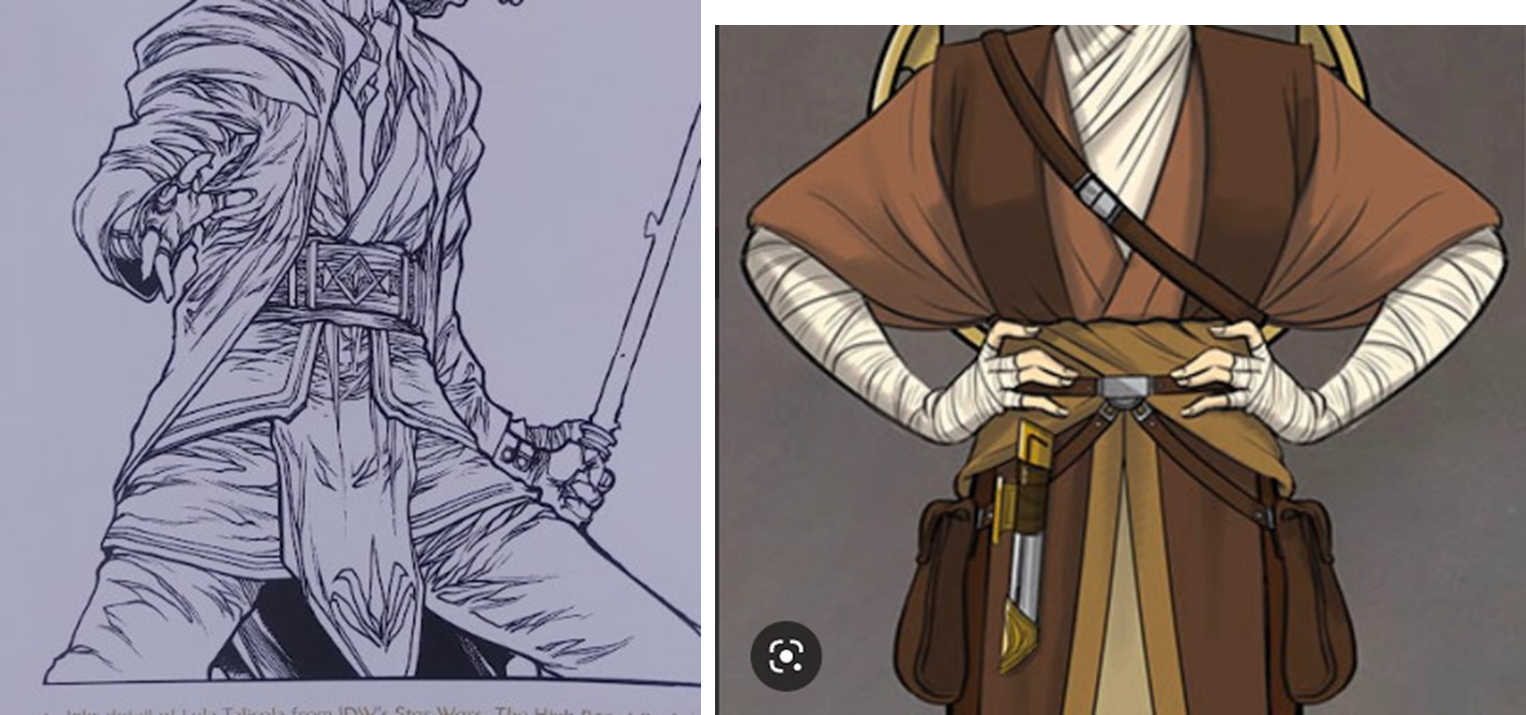Mission Uniform
High Republic mission outfits were worn by the Jedi during the High Republic era when they go into the galaxy and expect action. The colors are browns of varying shades for the outer tunic, white for the under tunics, and a variety of browns for tabards and obi.
Colors
All items not made of leather or metal share similar color schemes of brown and white/cream across mission outfits except where otherwise stated. Tabards should be a medium brown to slightly reddish brown. Outer tunics should be a darker shade of brown than the tabards, and can border on dark enough to appear almost black. Cap sleeves on the outer tunic should be the same color as the outer tunic. Shoulder pads should be the same color and material as the outer tunic if both are in the same costume. Pants/skirts should be white, cream, light to medium brown, golden brown or golden.
For Padawans only: Sashes are recommended to (But not required)match the color of your lightsaber blade.
Materials
Materials used should be durable since Jedi get into trouble when wearing these uniforms. Boots should be leather or leather like, as should gloves. All clothing parts should be of a durable material of medium to heavy weight and not be see-thru in any capacity. Materials used should not have additional patterns and patterned textures as concepts show a lack of excessive decoration.
Recommended Fabrics
Heavier, durable textured fabrics such as cotton twill, medium to heavy linens, duck cloth, wool suiting or melton wool, raw silk, microfiber, or other similar fabrics.
Disallowed Fabrics
Anything thin enough to be see-thru, shiny, has a sheen, or has a raised pattern. No quilting cotton, cotton sateen or sheer linens.
Required Items
Jedi mission outfits must have at minimum an outer tunic, an inner tunic, bracers, tabards, an obi or padawan sash, a Jedi belt with one pouch and a lightsaber clip, pants or a skirt, and boots.
Outer Tunic
Outer tunics are worn over the outer tunic and pants, but under tabards, obi and belt. The outer tunic should be a darker shade of brown than the tabards, and can border on dark enough to appear almost black. Any cap sleeves on the outer tunic should be the same color as the outer tunic. Shoulder pads should also be the same color and material as the outer tunic.
There are two common outer tunic styles found in concept and official art: Crossover and Surcoat. The Crossover outer tunic is the standard crossover-style tunic seen across eras for Jedi, just made of more durable materials. The Surcoat outer tunic can be either a plain or segmented tunic with no visible front or back opening that typically has a mandarin collar. Segmented outer tunics may have between 3-5 segmented sections that can be on the front section only. outer tunics are darker than tabards. They can range from darkish-medium brown to dark brown outer tunics follow all rules of main addendum with the following exceptions:
● outer tunics must be long enough to cover the crotch/backside
● outer tunics are either sleeveless, or have short single layer cap sleeves that extend less than 2 inches from the shoulder. Cap sleeves must be stiff and may be rounded or come to a central point.
● outer tunics may also have stylized cap sleeves in no more than two layers that extend to the middle of the bicep.
● outer tunics may have metallic trim, braid, or piping (though they may not have any other ornamentation)
● outer tunics may have visible vertical darts to achieve a tailored shape.
● outer tunic hems may come to a point in the front and back.
Inner Tunic
Inner tunics in the High Republic era are white. They are all long sleeved and should be tucked into the pants or skirt. They share the cross-over design of the standard Jedi over tunic. When worn with a standard cross-over outer tunic, the inner tunic’s collar should be visible. When worn with a segmented outer tunic, then only the sleeves need to be visible.
Tabards
Tabards for the High Republic are a way of individualization for the Jedi. Across concept art, book covers, and comics there is a huge variety in styles of High Republic era tabards. Generally the tabards are made of fabric, but can be leather or leather-like material. In the case that the tabards are constructed of leather or leather-like material, the obi does not need to be of the same material and may be fabric (please note this is a departure from the main Generic Jedi standard).
The standard draping over the shoulder tabards remains the most common style. This style can be worn a number of ways such as standard parallel lay, crossed over the chest, or closed below the obi in an apron style.
Tabards may also be
- Y-front with apron bottom front and back-embellishment does not need to extend to the back apron but does need to be on the tabards;
- Hybrid style per the main Generic Jedi standard;
- Medieval-style front and back with either a mandarin or v-neck collar and open sides.
- Vest-style with a mandarin collar and any of the following:
- Open sides,
- Closed sides
- The back wrapping around to the front above the belt;
- Y-style front and vest back with closed sides and a wide apron front and back
- Open sides,
All tabard styles EXCEPT vest and medieval may end at the obi in the back.
Tabards should be of a lighter brown than the outer tunic and are typically of a medium or reddish-brown color. In rare instances, they can be light brown, so long as they are lighter in color than the outer tunic.
- Tabards should be longer than the outer tunic and range in length between the mid-thigh and knees
- Tabards may have metallic trim, braid, or piping so long as the trim does not exceed 1” in width. Trim may have simple geometric designs.
- While not required, a High Republic Jedi design on the bottom of the tabards is allowed. For the medieval style tabard the design may also be on the chest. This can be applique, embroidery, painted or vinyl so long as it is done neatly with no fraying, bunching or splashes.
- Simple lines or scrollwork may be used on the upper tabards, but design and placement must be presented to GCC prior to construction.
- Tabards can end in a flat or pointed style (points must be symmetrical)
Obi
Padawan Sash
Padawan characters may choose to wear a sash instead of an obi. Sashes should fully circle the waist, be visible above and below the belt and have a long tail that hangs down to the knee at the front or on the right side. The knot of the sash must be below the belt and lie as flat as possible. They should have no ornamentation, and appear to be made from a single piece of fabric. Sashes should not be stiff and should drape freely on the hanging end. They are recommended to (but not required to) match the padawans blade color.
Belt
High republic belts are brown leather with metal accents and gold buckles. Like belts from the main addendum, they must appear continuous. They can feature ornamentation in the form of metallic trim and metallic studs or loops in gold or silver. Buckles may be plain geometric plates, geometric plates embossed or stamped with designs reminiscent of the heraldry on tabards, or be novel shapes based on said heraldry. The leather of belts is not embossed with patterns or heraldry. Belts must feature at least one pouch and a lightsaber clip. Three general styles may be made without pre-approval. Other belts may be used with approval from the Costuming team:
Original Trilogy Based Belt
These belts feature a single strip of leather at least 1 inch wide and no wider than 2.5 inches, with a single large buckle in the middle front. Like original trilogy belts, they do not feature excessive holes or large keepers. They may feature metallic bands or rings to attach the leather to the buckle.
Combo Belts
Prequel Based Belt
Prequel based belts feature the classic two-layer construction with a wider belt and a narrower belt. The wider belt should be between 2 and 3 inches. The narrow belt end ends at a buckle in the middle front, and the wider belt ends at the back with ends hidden by a keeper. The ends of the narrow belt may be tapered to where they meet the buckle. Other novel belt designs are also permitted, but must be pre-approved by the GCCs.
Belt Pouch
Pouches follow all rules of construction and ornamentation from the main addendum, except for the following
- Pouches may feature gold metallic trim
- Pouches may be suspended slightly below the belt by hidden straps or o-rings.
Bracers
Bracers can be made of leather, leather-like material or heavy duty fabric. They should fully enclose the arm from below the elbow to the wrist, and may appear continuous, have horizontal segments, or appear wrapped. Any fastenings must be hidden.
Adornments on the bracers should be kept to a minimum and are limited to gold edging. Bracers may be under the sleeves of a long sleeved outer tunic or over the sleeves of the inner tunic.
Bracers should be medium to dark brown in color. They should not have any gold edging or heraldry
Bracers may extend into or be worn with fingerless gloves in a matching brown color. If the bracer is a separate piece from the glove, the glove must be tucked into the bracer so that no skin is showing at the wrist.
Boots
Boots follow all rules of construction and fit from the main addendum. The exception being that wrap boots are not allowed for this template.
Pants, Skirts and Leggings
Pants, skirts and leggings follow all rules from the main addendum EXCEPT:
- They must be in shades of white, ivory, tan, cream, light to medium brown, or dark gold.
- Skirt hems may have simple gold trim or braid around the hem.
Saber
Sabers follow all rules from the main addendum. High republic features such as gold ornamentation are permitted but not required.
For Padawan characters using a sash rather than an obi, it is recommended (but not required) that the saber color match the sash color.
Optional Items
High Republic Mission Robes may have any or all of the following optional items. Please note that no other optional items from the main addendum are permitted.
Jewelry
High Republic mission robes may include simple metallic gold jewelry such as forehead tiaras or circlets, necklaces, bracelets, earrings, arm bands, brooches, hair clasps and hair beads.
- Jewelry may include one gemstone per piece.
- Necklaces must be choker-style or on chains under 16” to avoid coming off or striking the wearer during choreography.
- Bracelets may not be thin chain, ribbons or thin leather. Bracelets may slide on or have a secure clasp.
- Earrings may not dangle more than 2” below the earlobe for safety, and must be securely fastened to the ear.
- Brooches must be securely fastened to the fabric and not be of a weight that pulls the fabric
Cloak, Cape, or Robe
Capes, cloaks, and robes follow all rules of fit and construction from the main addendum EXCEPT:
- They may be made of lighter materials than the main addendum, such as silks or linens.
- They may end at calf or ankle length instead of ending a couple of inches off the ground.
- They may be lined in contrasting fabric within the gold/white/cream color palette.
- They may feature metallic trim, piping, or braid, though other types of patterns are not permitted.
- They may fasten with gold toned brooches and/or chains. Other types of visible fasteners may also be permitted if canon references from the High Republic are provided. If brooches are used, then the jewelry standards above apply.
Capes/Cloaks
- Capes and cloaks may fasten asymmetrically
- Capes and cloaks may have an added capelet layer in the shoulder area. If this layer is included, it should be the same color(s) as the rest of the cape or cloak.
Robes
- Robes may have ¾ length sleeves so long as the outer or inner tunic is long sleeved.
Kama or Battle Skirt
The kama must be made of heavy duty fabric or leather/leather-like material in shades of brown. The kama/battle skirt must be open in the front and may fall from a minimum 3-5 inches below the belt to just above the ankles. The kama may have simple, unornamented trim and/or lining in a different shade of brown that coordinates with the rest of the costume. The fastening must be hidden at the waist under the belt. If the kama falls below the knees, the top of the kama may be pulled out to flip over the belt.
Saber Holster
Saber holsters hang from the belt. They are made of leather or leather-like material with metal accents, and should functionally suspend a saber hilt when it has no blade attached. All saber holsters should either replicate an existing design from the high republic or be pre-approved by the GCCs.


